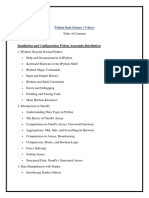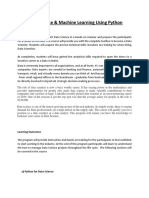0 ratings0% found this document useful (0 votes)
41 viewsData Science With Python ML Course Syllabus
Uploaded by
HarshithaCopyright
© © All Rights Reserved
We take content rights seriously. If you suspect this is your content, claim it here.
Available Formats
Download as DOCX, PDF, TXT or read online on Scribd
0 ratings0% found this document useful (0 votes)
41 viewsData Science With Python ML Course Syllabus
Uploaded by
HarshithaCopyright
© © All Rights Reserved
We take content rights seriously. If you suspect this is your content, claim it here.
Available Formats
Download as DOCX, PDF, TXT or read online on Scribd
You are on page 1/ 4
DATA SCIENCE WITH PYTHON COURSE CONTENT:
Data Science Overview
Data Science
Data Scientists
Examples of Data Science
Python for Data Science
Data Analytics Overview
Introduction to Data Visualization
Processes in Data Science
Data Wrangling, Data Exploration, and Model Selection
Exploratory Data Analysis or EDA
Data Visualization
Plotting
Hypothesis Building and Testing
Statistical Analysis and Business Applications
Introduction to Statistics
Statistical and Non-Statistical Analysis
Some Common Terms Used in Statistics
Data Distribution: Central Tendency, Percentiles, Dispersion
Histogram
Bell Curve
Hypothesis Testing
Chi-Square Test
Correlation Matrix
Inferential Statistics
Python: Environment Setup and Essentials
Introduction to Anaconda
Installation of Anaconda Python Distribution – For Windows, Mac OS, and
Linux
Jupyter Notebook Installation
Jupyter Notebook Introduction
Variable Assignment
Basic Data Types: Integer, Float, String, None, and Boolean; Typecasting
Creating, accessing, and slicing tuples
Creating, accessing, and slicing lists
Creating, viewing, accessing, and modifying dicts
Creating and using operations on sets
Basic Operators: ‘in’, ‘+’, ‘*’
Functions
Control Flow
Mathematical Computing with Python (NumPy)
NumPy Overview
Properties, Purpose, and Types of ndarray
Class and Attributes of ndarray Object
Basic Operations: Concept and Examples
Accessing Array Elements: Indexing, Slicing, Iteration, Indexing with Boolean
Arrays
Copy and Views
Universal Functions (ufunc)
Shape Manipulation
Broadcasting
Linear Algebra
Scientific computing with Python (Scipy)
SciPy and its Characteristics
SciPy sub-packages
SciPy sub-packages –Integration
SciPy sub-packages – Optimize
Linear Algebra
SciPy sub-packages – Statistics
SciPy sub-packages – Weave
SciPy sub-packages – I O
Data Manipulation with Python (Pandas)
Introduction to Pandas
Data Structures
Series
DataFrame
Missing Values
Data Operations
Data Standardization
Pandas File Read and Write Support
SQL Operation
Machine Learning with Python (Scikit–Learn)
Introduction to Machine Learning
Machine Learning Approach
How Supervised and Unsupervised Learning Models Work
Scikit-Learn
Supervised Learning Models – Linear Regression
Supervised Learning Models: Logistic Regression
K Nearest Neighbors (K-NN) Model
Unsupervised Learning Models: Clustering
Unsupervised Learning Models: Dimensionality Reduction
Pipeline
Model Persistence
Model Evaluation – Metric Functions
Natural Language Processing with Scikit-Learn
NLP Overview
NLP Approach for Text Data
NLP Environment Setup
NLP Sentence analysis
NLP Applications
Major NLP Libraries
Scikit-Learn Approach
Scikit – Learn Approach Built – in Modules
Scikit – Learn Approach Feature Extraction
Bag of Words
Extraction Considerations
Scikit – Learn Approach Model Training
Scikit – Learn Grid Search and Multiple Parameters
Pipeline
Data Visualization in Python using Matplotlib
Introduction to Data Visualization
Python Libraries
Plots
Matplotlib Features:
1. Line Properties Plot with (x, y)
2. Controlling Line Patterns and Colors
3. Set Axis, Labels, and Legend Properties
4. Alpha and Annotation
5. Multiple Plots
6. Subplots
Types of Plots and Seaborn
Data Science with Python Web Scraping
Web Scraping
Common Data/Page Formats on The Web
The Parser
Importance of Objects
Understanding the Tree
Searching the Tree
Navigating options
Modifying the Tree
Parsing Only Part of the Document
Printing and Formatting
Encoding
Python with Hadoop basic concepts.
THANK YOU
You might also like
- Data Science Training in Naresh I Technologies100% (3)Data Science Training in Naresh I Technologies18 pages
- 20191120122749-Data Science Certification TrainingNo ratings yet20191120122749-Data Science Certification Training4 pages
- Data Sciences with Python Machine Learning (2-in-1 course)No ratings yetData Sciences with Python Machine Learning (2-in-1 course)3 pages
- Data Science With Python Updated BrochureNo ratings yetData Science With Python Updated Brochure13 pages
- Programming For Data Analytics Introduction100% (2)Programming For Data Analytics Introduction32 pages
- Mastering Python for Machine Learning (with Data Science)No ratings yetMastering Python for Machine Learning (with Data Science)3 pages
- Data Science Training Syllabus 27082021No ratings yetData Science Training Syllabus 2708202121 pages
- Functional Programming in Python SyllabusNo ratings yetFunctional Programming in Python Syllabus3 pages
- Python Data Science Group Bootcamp NYC (Affordable Machine Learning)No ratings yetPython Data Science Group Bootcamp NYC (Affordable Machine Learning)16 pages
- 22am901 Data Science Using Python Unit 2No ratings yet22am901 Data Science Using Python Unit 2116 pages
- Python For Data Science - ANR PL - FinalNo ratings yetPython For Data Science - ANR PL - Final194 pages
- Alchemyst Data Science and Machine Learning ProgramNo ratings yetAlchemyst Data Science and Machine Learning Program4 pages
- Dms - 5e147898f022bDS and ML With Python LibrariesNo ratings yetDms - 5e147898f022bDS and ML With Python Libraries2 pages
- Gujarat Technological University: Overview of Python and Data StructuresNo ratings yetGujarat Technological University: Overview of Python and Data Structures4 pages
- Learning Data Mining with Python Layton download pdf100% (5)Learning Data Mining with Python Layton download pdf55 pages
- Python Data Science Intro To ML - Course 01No ratings yetPython Data Science Intro To ML - Course 013 pages
- Data Science Course and Machine Learnign Using PythonNo ratings yetData Science Course and Machine Learnign Using Python3 pages
- Course Title 2UST504 Python For Data ScienceNo ratings yetCourse Title 2UST504 Python For Data Science4 pages
- Statistics and Machine Learning in PythonNo ratings yetStatistics and Machine Learning in Python300 pages
- Data Science Course in Hyderabad - InnomaticsNo ratings yetData Science Course in Hyderabad - Innomatics10 pages
- Course Curriculum: Internship On PythonNo ratings yetCourse Curriculum: Internship On Python29 pages
- Statistics and Machine Learning in PythonNo ratings yetStatistics and Machine Learning in Python218 pages
- Data Mining Essen, Als 2: Data Mining in Prac, Ce, With PythonNo ratings yetData Mining Essen, Als 2: Data Mining in Prac, Ce, With Python31 pages
- Master+Data+Science,+Data+Analytics+and+Machine+Learning+Using+Python (1)No ratings yetMaster+Data+Science,+Data+Analytics+and+Machine+Learning+Using+Python (1)16 pages
- Mastering Python Scientific Computing: A complete guide for Python programmers to master scientific computing using Python APIs and toolsFrom EverandMastering Python Scientific Computing: A complete guide for Python programmers to master scientific computing using Python APIs and tools4/5 (1)
- Data Science with Python: Unlocking the Power of Pandas and NumpyFrom EverandData Science with Python: Unlocking the Power of Pandas and NumpyNo ratings yet
- Unit-6 - Data Visualization and Graph AnalyticsNo ratings yetUnit-6 - Data Visualization and Graph Analytics27 pages
- Prediction of central nervous system oxygen toxicity symptoms using electrodermal activity and machine learningNo ratings yetPrediction of central nervous system oxygen toxicity symptoms using electrodermal activity and machine learning8 pages
- Cluster Analysis Using Dicer: Install - PackagesNo ratings yetCluster Analysis Using Dicer: Install - Packages8 pages
- By Lior Rokach and Oded Maimon: Clustering MethodsNo ratings yetBy Lior Rokach and Oded Maimon: Clustering Methods5 pages
- Jeong 等 - 2023 - Noisy adversarial representation learning for effeNo ratings yetJeong 等 - 2023 - Noisy adversarial representation learning for effe10 pages
- LHM Machine Learning and Intelligent Data Analysis 2022-23No ratings yetLHM Machine Learning and Intelligent Data Analysis 2022-236 pages
- Application of Predictive Maintenance in Manufacturing With TheNo ratings yetApplication of Predictive Maintenance in Manufacturing With The5 pages
- Plant Disease Diagnosis and Image Classification Using Deep LearningNo ratings yetPlant Disease Diagnosis and Image Classification Using Deep Learning16 pages
- The Full Stack Data Scientist BootCamp® CurriculumNo ratings yetThe Full Stack Data Scientist BootCamp® Curriculum55 pages
- Thesis Topics For Human Development and Family Studies100% (1)Thesis Topics For Human Development and Family Studies7 pages
- Comparing LLMs Using A Unified Performance Ranking SystemNo ratings yetComparing LLMs Using A Unified Performance Ranking System13 pages
- Deep Learning Detection of Facial Biometric Presentation AttackNo ratings yetDeep Learning Detection of Facial Biometric Presentation Attack18 pages
- Discover-the-Secret-to-Legendary-IT-ServiceNo ratings yetDiscover-the-Secret-to-Legendary-IT-Service24 pages
- Classification of Parkinsons Disease Based On Acoustic Characteristics Using FeaNo ratings yetClassification of Parkinsons Disease Based On Acoustic Characteristics Using Fea6 pages

























































































